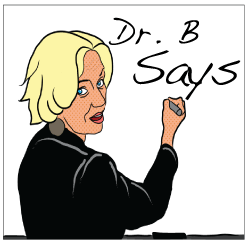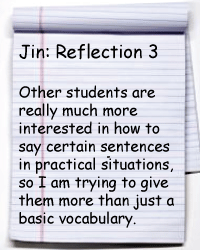 Basic and Survival Language
Basic and Survival Language
 It is quite common that in certain situations, students who are just learning English are able to communicate and get along quite well with the other students. These students, however, may struggle when it comes to academic work. This difference in abilities reflects how people learn different types of vocabulary, depending on the situation. In the case of Daniel’s new student, for example, he seems to be doing quite well with what is known as “survival language”, but has more trouble with “basic language”. Being aware of this difference can allow teachers to assist students in achieving success in all aspects of their communication. It is quite common that in certain situations, students who are just learning English are able to communicate and get along quite well with the other students. These students, however, may struggle when it comes to academic work. This difference in abilities reflects how people learn different types of vocabulary, depending on the situation. In the case of Daniel’s new student, for example, he seems to be doing quite well with what is known as “survival language”, but has more trouble with “basic language”. Being aware of this difference can allow teachers to assist students in achieving success in all aspects of their communication. |
|
What is the difference between active and passive vocabulary?
Learners of a foreign language realize that words are essential, and the lack of them leads to feelings of insecurity. A distinction needs to be made between:
- active or productive vocabulary – words which students understand, can pronounce correctly, and use constructively in speaking and writing and;
- passive or receptive vocabulary – words that students recognize and understand when they occur in a particular context, but which they cannot produce correctly themselves
What is BASIC language?
 In selecting which vocabulary to teach or expose students to, a number of factors should be considered. It is often said that a vocabulary of 300-500 words is sufficient for beginning communication – what is not so often said is which 300-500 words. An inverted triangle model is used to identify the two types of vocabulary needed in early second language learning. The 300-500 words are referred to as BASIC language and it consists of about ten words or phrases in each of 30-50 categories. Basic language would include much of the categories or themes a native speaking child of two or three has been exposed to. Categories include words for food, clothing, family members, buildings, numbers, weather, time, greetings, interactional phrases, questions, description, verbs of motion, verbs of request, nature, furniture, household objects, transportation, etc.
In selecting which vocabulary to teach or expose students to, a number of factors should be considered. It is often said that a vocabulary of 300-500 words is sufficient for beginning communication – what is not so often said is which 300-500 words. An inverted triangle model is used to identify the two types of vocabulary needed in early second language learning. The 300-500 words are referred to as BASIC language and it consists of about ten words or phrases in each of 30-50 categories. Basic language would include much of the categories or themes a native speaking child of two or three has been exposed to. Categories include words for food, clothing, family members, buildings, numbers, weather, time, greetings, interactional phrases, questions, description, verbs of motion, verbs of request, nature, furniture, household objects, transportation, etc.
What is SURVIVAL language?
Alongside BASIC language learners need to develop SURVIVAL language. SURVIVAL language consists of the words and phrases encountered in daily situations where the learner hears and can use the SL. For many students survival language is classroom language - the classroom phrases relating to school rules, playing games, giving and getting instructions. If a long-term visitor or immigrant is immersed in the cultural milieu where the language is used then SURVIVAL language will include words and phrases associated with daily shopping, filling out application forms and making appointments. (Alberta Education, 1992).
 |
Using the above information as a starting point to help you, create a chart with as many examples of BASIC and SURVIVAL language as you can think of. |



